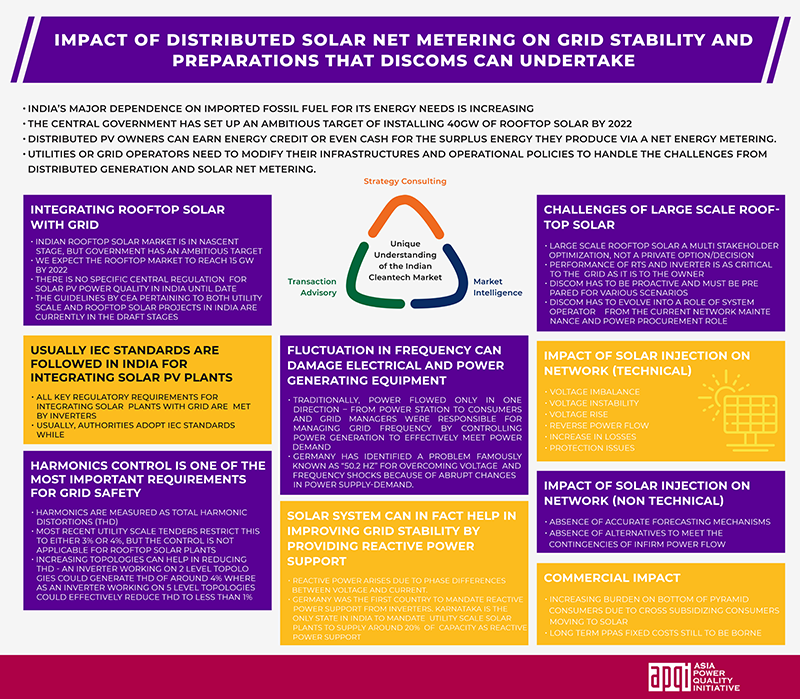| Webinar Date: | 03-04-2018 |
| Webinar Time: | 04:00PM to 05:30PM |
INTRODUCTION
|
India’s major dependence on imported fossil fuel for its energy needs is increasing renewables share especially of solar. The central government has set up an ambitious target of installing 40GW of rooftop (distributed) solar by 2022 but the installed capacity has only crossed the 1GW mark till date. Hence, for quick deployment of the remaining capacity, the supporting market mechanisms must be robust and streamlined. Net metering is one such mechanism that allows residential and commercial customers who generate their own electricity from solar power to feed electricity, which they do not use, back into the grid. In addition to helping consumers reduce their energy bills, it is also supposed provide financial relief to the distribution companies (DISCOMs) through consumer default risk mitigation, reduction of AT&C losses and help cut down the per-capita energy footprint. |
With the growth envisaged in solar PV deployment, it seems difficult to manage it because of its nature of variability and volatility. As there will be more physical adjustments in the system, more computations and resources will be required to control the grid. There are various factors posing a challenge to the rise of solar in India and net metering is just one of them primarily for distributed generation. Distributed PV owners can earn energy credit or even cash for the surplus energy they produce via a net energy metering. Grid unreliability is another issue hampering solar PV systems since the electricity generated using solar cannot be used in case of a grid outage due to anti islanding protection.
Discoms seem to be reluctant in adopting net metering guidelines due to loss of business/ profitable customer base. Utilities or grid operators need to modify their infrastructures and operational policies to handle the challenges from distributed generation and solar net metering. Utilities need to be responsible for coping with the variability and volatility of distributed PV generation. Policy makers, meanwhile, are coming up with multiple mechanisms to incentivize net-metering adoption from both sides to help Discoms improve their financial health and to enable a reliable energy supply.
QUESTIONS AND ANSWERS
As inverter generates reactive power, can we use inverter instead of capacitors bank to maintain power factor of the system?
Mr. Mudit Jain: Usually solar inverters used on a industries are smaller in size compared to the connected load and do not have the capacity to provide the requisite reactive power support. In most cases, capacitor banks will still be operational even after solar system is installed.
Does system harmonics has any impact on Solar power equipment and vice versa is RE systems contributing to higher harmonics?
Mr. Mudit Jain: Yes
After 2022, who will be the consumers of Discoms ?
Mr. Mudit Jain: It will be the same set of people. It is unlikely that any RE generator will completely replace DICOMs by 2022. However, the total power demand from DISCOM’s end may come down if rooftop solar systems become prevalent.
What are the metering and instrument transformer class requirement for solar Roof Top PV plants of different sizes? Is it uniform across all states?
Mr. Mudit Jain: The class of meters usually varies with size of installation. Most states are trying to emulate the similar standards for meter standards, but there are variations in different states for classification of system sizes.
Why only 40 % of DTC transformer capacity are allowed for back feeding of solar energy by discom for Maharashtra
Mr. Mudit Jain: Initially, there were no means to determine how much loading of transformer can be allowed therefore most states have set DTR loading capacity at 15%, which is a conservative estimate. Even today, many states have capped it at 15% and Maharashtra is one of the progressive states which allow loading up to higher DTR capacity. To evaluate the true potential of DTR loading capacity, a detailed load flow study is required.
Is Energy Audit mandatory for roof top solar
Mr. Mudit Jain: No
Question for improving output for solar park developer -- Is there a requirement for the implementation of Dynamic Reactive Power Compensation?
Mr. Mudit Jain: Reactive Power Support is made mandatory only in Karnataka. However, the mandate doesn’t differentiate between static or dynamic reactive power support.
How can India get a cost effective solar cells and complete setup ? who are present Indian manufacturers ?
Mr. Mudit Jain: This is a much larger question and there are no easy answers.
MNRE has published list of all manufacturers on their website.
How in Residential building we can use solar system as there are only common lift and motor for water is only used in day time that too for less time?
Mr. Mudit Jain: It depends on the electrical system, but through net-metering the total power demand can be off-set even though the power is not being used at the time of generation.
Can we improve power factor by using inverter and solar power?
Mr. Mudit Jain: Yes
Is there any galvanic isolation requirement in practice beyond a certain size of plant to ensure power quality?
Mr. Mudit Jain: Most inverters come pre-attached with isolators, but for large systems, CEIG may ask for installation of an external device.
Mr. Sugata Mukherjee: Usually large Inverters are having transformers and galvanic isolation is in built feature.
What are the steps being taken for the implementation of IEGC across India as is applicable world wide?
Mr. Mudit Jain: None that I am aware about.
Mr. Sugata Mukherjee: This question is not clear. May be we should talk to concerned person.
If for example we have 2/3 KW of motor running for 6 hours in a day, when we will get the break even of our cost of solar installation for 70 x 70 feet of building roof open space we have?
Mr. Mudit Jain: It depends on the power cost that the consumer is paying and the irradiation at the site. To take an average case, the break even period will be 5-7 years.
Can a inverter acts as a active harmonic filters?
Mr. Mudit Jain: Inverters are designed to reduce the harmonics produced by solar plant, but it may not act as a filter for outside power.
Is Demand response helpful to RE stability or RE helps in Demand Response? What is more rational and practical?
Mr. Mudit Jain: RE doesn’t help in demand response at all. But if we want to scale RE, we need a highly effective system of demand response to ensure grid stability.
Mr. Sugata Mukherjee: RE has inherent challenge of variability and uncertainty due to weather fluctuations. Due to this Grid stability can be adversely impacted. Demand Response help Utilities to address these challenges, particularly when RE increases to significant proportion of supply portfolio.
Can we feed directly DC to the electrolytic cell, generated by roof top PV generator?
Mr. Mudit Jain: A DC controller would be required before this kind of arrangement be tried.
Customers understand its usage & benefits still they insist on paybacks , so how to proceed ?
Mr. Mudit Jain: It’s a marketing technique and your sales representative should device strategies around it.
Mr. Sugata Mukherjee: Proper Payback calculation needs to be done and conveyed to Customers. People are adapting Rooftop Solar gradually because of high initial investment requirement.
Is there any study of effect of RTS on power quality (in percentage) viz a viz other issues or factors those affect power quality?
Mr. Mudit Jain: There are multiple studies done by various international agencies.
Does this reactive energy impacts the net metering here in India ? Any seen cases?Mr. Mudit Jain: There is no study that I am aware of, which has studied this impact.
Mr. Sugata Mukherjee: Reactive Energy is also considered for billing for bulk consumers (KVAh Billing) in most of the utilities in India. Hence there is not much impact in Net Metering.
Is there is any list of manufactures who's product has been rated based on the performance & longevity ?? just as you see in Amazon ??
Mr. Mudit Jain: No such list from any trustworthy reputed source is available.
Mr. Sugata Mukherjee: MNRE had published such list. However, basis of selection has not been mentioned.
Are there any standards existing/proposed for inverter or ancillary items in RTS?
Mr. Mudit Jain: CEA has proposed draft standards for inverters to be installed on RTS.
States where the tariffs are low like Rs 4-6 per units, there the breakeven point is not achieved within 4-5 years. But it takes more than , so what do you suggest.
Mr. Mudit Jain: It is a marketing effort which is required as the tariffs are going to increase in future.
Disclaimer: The above suggested are expert views and are not recommended solution. Arriving at any solution requires to carry out detailed study based on utility key parameters.
WHY SHOULD YOU ATTEND?
This webinar brings experts from the field of service provider/utility and technical consultant to share their experiences on the following topics:
Benefit 1: Impact of Solar net metering mechanism on the grid and its components (Distribution Transformers)
Benefit 2: Effect of solar PV integration on Power Quality
Benefit 3: Best practices to be followed by Indian utilities to ensure grid stability
PANEL OF EXPERTS

Mr. Sugata Mukherjee
Tata Power Delhi Distribution Limited, Head of Group (Solar & New Businesses)
Key Talk Points
- With solar growth envisaged how does internal mechanism of net metering work?
- What is the effect of Solar net metering mechanism on the grid and its components (specially on distribution transformers)?
- What specific protection devices are required to ensure reduction in Power quality issues (like voltage imbalance and harmonics) with integration of solar systems?
- Any simulated case study depicting effect of net metering on grid stability?
Download Presentation:
Mr.-Sugata-Mukherjee_APQI-Webinar.pdf
Mr. Mudit Jain
Bridge to India Energy Pvt. Ltd., Senior Manager-Consulting
Key Talk Points
- Are Indian utilities prepared to manage the solar grid integration and undertake net metering mechanism?
- What are the technical and commercial challenges faced by Discoms with solar net metering?
- How Indian utilities will manage and monitor load on the distribution transformers (being a key element of the grid) with augmentation of solar PV systems?
- What are the best practices undertaken by global utilities to ensure power quality is maintained with solar grid-integration?
